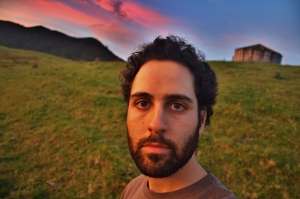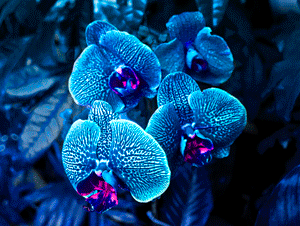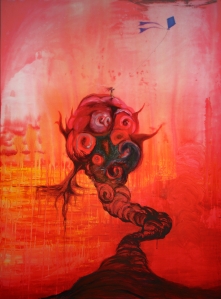
This interview was originally posted on June 8, 2011 for Winking At A Girl In The Dark.
Nikolas Kazoura is a multimedia artist from Los Angeles, California. He studied engineering and digital art at The University of California, Irvine and has worked both as an engineer and digital artist since graduating in 2008. Nik’s creative expression takes the form of paintings, photographs, and sculptures. His most recent body of work combines these media forming intricate scenes frozen in time, pushing the boundaries of contemporary psychedelic art. We were so pleased to be able to learn a bit more about Nikolas and his work.
CM: Where did you grow up?
NK: I was born in Los Angeles and spent most of my life in Huntington Beach.
CM: Were you interested in art at a young age or was that something that came later?
NK: I have been interested in art ever since I can remember. At a young age I would constantly draw my surroundings. Eventually I shifted away from observational art and turned to surrealism and abstract work.
CM: What were some early sources of inspiration?
NK: Early colorful and imaginative influences came from video games (Sonic, Mario, Zelda), comics, TV / movies and children’s books like those of the great Dr. Seuss. If I had to pick an early influence that still shows through in my art today it would be Seuss. His style is timeless.
CM: I know you studied engineering in school, among other things. How has that background played into your approach to your art?
NK: Engineering is always a large part of my creative process. I find it strange when kids are taught to place art and science into separate categories. Without science art wouldn’t exist, and without art, we would have nothing to live for.
With my current resin sculpture work, once a concept is born, there is a lot of design work to be done before the piece can take physical form. From mold making, to resin casting, the design phase can take as long as the creation process. When working with such costly materials there is no room to miscalculate. Even when I do my best to get the design right, in the end anything can happen.
CM: You are a painter, a photographer, and a sculptor. Can you talk a bit about what you love about each of those mediums?
NK: Painting is a very relaxing and reflective process for me. Being a visual artist, much of my creative time is spent in solitude and painting is a great way for me to turn off the chatter in my mind and allow the creativity to flow freely onto the canvas.
Many consider photography to be an art form that captures reality. The ability to freeze a moment from the motion of time is as far from reality as I can imagine. I love photography because it allows us to vicariously live in a split-second moment forever. It’s basically a low-budget time machine.
Because I haven’t taken many formal art classes, sculpture has always looked like a very daunting process. After finally having the courage to dive into it, however, sculpture has become a large part of my current creative process. I enjoy it because it is truly a hands-on experience where I can see and feel a change taking place before my eyes.
CM: What, if anything, feels limiting in each?
NK: Other than my own mental limitations, I do not feel limited with any medium I work with.
CM: I read that your life feels like you are constantly moving and in disarray. Can you talk about how you experience both the motion and the chaos?
NK: Although at times I feel like I am trapped in a whirlwind, the chaos in my life is truly a choice. Because I feel the need to be in motion, I rarely subscribe to a routine. Every day is different. I welcome change and see it as an opportunity to expand.
CM: Are you a planner when it comes to your art or are most things born out of some degree of spontaneity?
NK: I struggle with this question on a daily basis. I have natural tendencies to plan every step of the way. Because my path has gone in so many random and wonderful directions, I try to stay unattached to plans. This allows me to follow my intuition when great opportunities arise.
CM: Your most recent body of work focuses on lenticular imagery, using certain lenses, and a combination of multiple images, to create the illusion of depth. Can you explain a bit about the complexity of the process?
NK: After spending four months learning how to create a successful large-scale lenticular image I still didn’t fully understand how the technology worked. Half the time my explanation leaves listeners with a blank stare…so cross your fingers:
If you’ve ever seen a postcard, bookmark, print advertisement, or movie poster that appeared 3D or animated, it was most likely a lenticular image. This is not to be confused with a hologram, which also appears 3D, but uses lasers to produce the illusion of depth. To create a 3D lenticular image, the first step is to produce multiple images of the same object at slightly different angles – almost as if you were rotating an object while photographing it. These images are then digitally combined into a single composite image. The composite image is made up of tiny columns about 1/4″ wide. Each of those columns contains a one pixel wide strip of each image. The composite print is then attached to a lenticular panel. The panel is made up of vertical lenses. Each lens magnifies one strip beneath it, showing the viewer only one of the original images. Because our eyes are horizontally separated, each eye sees a slightly different angle thus tricking you into seeing depth.
If you are still confused, I wrote a helpful document with visual aids to better explain the process: http://nkazoura.com/images/sale/how_does_it_work.pdf
CM: The idea/technology behind creating images that seem to move when viewed from different angles dates back to the late 1600’s. How important/inspiring is it for you to be doing something “new” with that? How do you keep those new ideas fresh?
NK: Because of its complex production process and eye-catching presence, lenticular images have almost exclusively been produced for commercial use. Living in the digital age I feel privileged to have the resources to be able to bring such a wonderful technology to the contemporary art scene. The lenticular effect is great, but I cannot rely on the effect alone to capture an audience’s attention. I take great care in style and composition to make each piece my own.
CM: Is there something appealing about being able to be drawn in by something that is illusory? Or about being able to create something that allows people to experience a slight illusion?
NK: Speaking specifically about lenticular imagery, its fun to work with a medium that people don’t normally associate with fine art. I enjoy watching people stare with a puzzled look on their faces, looking behind the piece to see if there’s actually something there giving it depth. Because people can’t relate to it, some may mark it off as gimicky. As someone who assembles these pieces by hand, I must say it is a very long and tedious process.
Speaking of art in general, the greatest art is the kind that grabs us, pulls us in, plays with our emotions as if we were experiencing the real thing. These illusions are everywhere, from film, tv, video games, painting, photography…Many people live their lives through the illusion of art. It has universal appeal.
CM: I really enjoyed your interpretation of “The Rose That Grew From Concrete” (2010). Does it sometimes feel like that, living an artist’s life? That one must push through something seemingly impossible to be able to bloom into one’s full potential?
NK: That piece is named after a poem by Tupac Shakur. Having a background in engineering, as well as art and design, I do not feel as though I am living the typical artist’s life. The term “full potential” assumes that there is an end goal. I do not see my artistic process as progressing to any final point. It is always changing, not for better or worse.
CM: You were Artslant’s first 2011 Showcase Winner in the mixed-media category for your piece, “Supermassive Black Hole.” Congratulations. How did you come upon the idea for that piece?
NK: Thank you. “Supermassive Black Hole” is a companion to a lenticular piece entitled “Into the Supermassive”. The idea was to immerse the viewer in a vortex; initially it was a purely abstract piece intended to push the lenticular depth boundaries to their limits. I came to really appreciate the composition and wanted to build a physical version of it, so “Supermasive Black Hole” became an extension of that idea. It is composed of mixed media embedded in transparent resin and depicts a nomad on a journey, contemplating whether or not to enter the unknown.
CM: What frustrates you about your work?
NK: Time is my main enemy when it comes to art. I have a hard time doing things the easy way. I enjoy complexity, variety, and developing a systematic approach to each piece. This results in very long turn-around times which can be frustrating.
CM: One of your paintings features a young woman lying down with a dragon sleeping peacefully at the foot of her bed. What brings you peace in the midst of all the calamity? Or does motion bring you peace? Knowing you are dancing around the trap of stagnation?
NK: What brings me peace is knowing that I am a mere spec of dust on the timeline of life. I’m here to smile and be free.
CM: Where would you like to see yourself in, say, ten years?
NK: I really can’t begin to guess where I will be in 10 years. Whatever it is I am doing, I will always be creating visual art. I also have a passion for working with children. It would be great to have a gig combining art and science with kids.
CM: Where can people view your work and art for sale?
NK: Originals, prints, and limited edition 3D Lenticular images are available for sale through my website www.nkazoura.com.
CM: Any final thoughts?
NK: If any readers are also artists with a passion for science and engineering, they may be interested in checking out my current pedal-powered flight concept hitting the skies late 2012: http://www.youtube.com/watch?v=sI9Cu7RSBaI.
—
To learn more about Nikolas Kazoura and his art, please visit his website at www.nkazoura.com.




